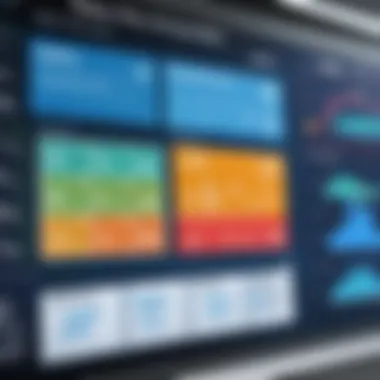Utility Locate Ticket Management Software Explained


Intro
In the domain of underground utility management, efficiency is paramount. Utility locate ticket management software plays a vital role in streamlining this process. This software aids industries that depend on well-organized ticket handling while ensuring compliance with numerous safety standards. As organizations face increasing pressures to manage their underground infrastructure effectively, understanding the functionalities of this specialized software becomes essential. This article explores the critical aspects of utility locate ticket management software, including its features, benefits, and best practices.
Software Overview
Brief Description of Software
Utility locate ticket management software enables organizations to effectively manage the lifecycle of locate requests. Typically, these requests originate from contractors or municipalities wanting to dig or modify the ground. The software serves as a central hub that collects, processes, and distributes locate tickets. Users can prioritize requests according to urgency, record responses from utility owners, and monitor interactions continuously.
Key Features and Functionalities
This type of software comes with several key features that enhance operational efficiency:
- Automated Ticket Processing: The software automates the capture and response to tickets, significantly reducing manual work.
- Real-Time Tracking: Stakeholders can monitor the status of requests in real-time, ensuring timely responses.
- Compliance Management: The software assists in ensuring that all safety protocols are met, providing an auditable trail when necessary.
- Reporting Tools: Built-in reporting functionalities help organizations analyze performance metrics, identify bottlenecks, and optimize workflows.
- Integration Capabilities: Compatibility with existing systems allows for seamless operations, aligning ticket management with other business processes.
Detailed Comparison
Comparison with Competitors
When evaluating different software options, it is important to compare functionalities and user experiences. Esri ArcGIS is noted for its geographic information system capabilities, while Utility Locating Field Software may excel in real-time data collection. Choose a solution based on specific operational needs and the scalability of features offered.
Pricing Structure
Pricing can vary greatly based on functionality and support options. It is common to find tiered pricing models, where basic packages provide essential features while advanced tiers encompass full-fledged functionalities. Some well-known providers may offer subscription payments based on the number of users, while others provide one-time licensing fees. Industry professionals should consider both the short-term and long-term costs when selecting software.
"The right utility locate ticket management software can transform operational frameworks, enhancing not only efficiency but also safety compliance throughout the industry."
Preamble to Utility Locate Ticket Management Software
Utility locate ticket management software plays a crucial role in streamlining the processes involved in managing underground utility systems. Its importance lies in its ability to enhance operational efficiency while simultaneously ensuring compliance with safety regulations. In industries where the management of subsurface utilities is critical, this software provides significant advantages in handling the complexities of ticket management, workflow management, and communication among stakeholders.
Definition and Purpose
Utility locate ticket management software is designed to facilitate the efficient handling of requests to locate underground utilities before excavation projects commence. The primary purpose of this software is to automate and simplify the ticketing process, which traditionally involved extensive manual effort and risk for errors. By providing a systematic approach to ticket management, it helps organizations manage their responsibilities more effectively.
The software enables utility companies and contractors to receive, track, and respond to locate requests in a more organized manner. This functionality minimizes the chances of missed requests or miscommunication, which can lead to safety hazards, project delays, or costly damages. For companies operating in this space, integrating such software becomes an essential tool for maintaining operational excellence and adhering to legal mandates.
Evolution of Ticket Management Systems
The journey of ticket management systems has evolved significantly over time. In the early days, utility locate management relied heavily on paper-based processes, which were time-consuming and prone to human error. As technology advanced, many organizations turned to electronic systems, which improved ticket tracking and communication among teams.
Over the years, these systems have incorporated more sophisticated features, such as automated alerts, real-time updates, and integration with Geographic Information Systems (GIS). This evolution has enabled companies to make data-driven decisions, enhance collaboration, and better allocate resources. The current trend focuses on leveraging cloud-based solutions that offer greater flexibility and scalability, ensuring that companies can adapt to the changing landscape while maximizing their efficiency.
The shift from paper-based systems to automated software reflects not only technological advancements but also a broader understanding of the importance of proactive asset management.
Ultimately, the evolution of utility locate ticket management software reflects a growing awareness of its role in safeguarding both the public and the infrastructure. As industries continue to face increasing regulatory standards and operational challenges, adopting advanced software solutions becomes vital for success.
Importance of Utility Locate Management
Utility locate management encompasses essential processes and systems that ensure the safe handling of underground utilities. The significance of effective utility locate ticket management cannot be overstated in industries that rely heavily on these underground systems. It integrates operational efficiency with safety compliance, creating a cornerstone for sustainable practices in resource management.
Safety and Compliance
Safety is the primary concern when it comes to utility locate management. Digging without locating underground utilities can result in disastrous outcomes, including accidents, injuries, and damage to infrastructure. Utility locate ticket management software serves as a vital tool to minimize these risks. The software helps organizations adhere to safety regulations by providing accurate and timely information regarding the location of utilities.


The compliance aspect is equally important. Many jurisdictions enforce strict regulations regarding the handling of underground utilities. Failing to comply can lead to penalties and legal issues. Utility locate management software assists companies in tracking ticket requests, ensuring that every inquiry is addressed promptly. This systematic approach helps maintain a compliance trail, useful for audits and inspections. The software often includes features that allow for easy documentation and reporting. This can lead to quicker emergency response times and improved overall safety.
Efficiency in Operations
Operational efficiency is another critical factor in utility locate management. Traditionally, manual processes were prone to errors and delays, creating bottlenecks in workflows. Utility locate ticket management software automates many tasks, significantly reducing processing time. With features like automated ticket routing and real-time notifications, organizations can respond to locate requests with unparalleled speed.
In addition, the software facilitates better communication among teams. Enhanced collaboration tools within the software allow for sharing of information, making it easier for technicians and field workers to coordinate on projects. This leads to a seamless flow of information, thus decreasing downtime and improving overall productivity. With a clearer insight into current projects and workload, decision-makers can allocate resources more efficiently, ensuring that they meet project deadlines without compromising safety or quality.
In summary, utility locate ticket management is crucial for both safety and efficiency. By implementing effective management systems, organizations can significantly enhance their operational capabilities and ensure compliance with safety standards. These benefits not only contribute to productivity but also ensure that businesses can operate without the fear of catastrophic failures.
Key Features of Utility Locate Ticket Management Software
The key features of utility locate ticket management software play a critical role in optimizing the processes related to underground utility management. These features directly contribute to improved safety, operational efficiency, and compliance with industry regulations. In an environment where precision is paramount, understanding these functionalities helps decision-makers and IT professionals select the right tools to meet their organizational needs.
Automated Ticket Processing
Automating ticket processing simplifies the workflow involved in utility locating. It eliminates manual input and reduces the likelihood of human error. Through automation, tickets can be generated, assigned, and tracked without human intervention. This feature leads to quicker response times, which is essential for maintaining safety and minimizing project delays. By employing advanced algorithms, these systems ensure that notifications are sent promptly, providing real-time updates to all involved parties. Automated ticket processing is beneficial in scaling operations, especially in larger organizations handling numerous tickets daily.
Real-time Notifications and Updates
Real-time notifications serve as a cornerstone in effective ticket management. The ability to receive immediate updates on ticket status enhances communication among stakeholders. This feature allows professionals to stay informed about requests, approvals, and completions. It supports proactive management and enables teams to react swiftly to emerging issues. This is particularly important in utility locating, where delays can lead to significant hazards.
Integration Capabilities
Integration capabilities are essential for ensuring that utility locate ticket management software works seamlessly with existing systems. This interoperability facilitates better data management and workflow continuity across different departments.
APIs for Third-party Integrations
APIs for third-party integrations allow the utility locate management software to connect with various tools and platforms used by an organization. This capability enables the software to enhance its functionality beyond the basic features. A key characteristic of APIs is their flexibility, allowing customization based on specific organizational needs. They offer considerable benefits by ensuring data consistency and reducing manual data entry. However, managing APIs requires a skilled IT team to maintain and address any issues that arise.
Data Synchronization
Data synchronization ensures that information across multiple systems remains consistent and current. This feature is key in providing accurate insights for decision-making processes. Coordinating data streams from various sources helps maintain a reliable flow of information regarding tickets and utilities. While data synchronization streamlines operations and enhances collaboration, it may impose complexity in system setup and maintenance.
Reporting and Analytics
Reporting and analytics are vital capabilities that transform raw data into actionable insights. They enable organizations to assess performance metrics, evaluate response times, and identify trends in utility locating activities. This analysis is essential for informing strategic decisions and improving processes over time. With robust reporting tools, companies can generate detailed reports that visualize key performance indicators, supporting a data-driven approach to management.
Selecting the Right Utility Locate Ticket Management Software
Selecting the appropriate utility locate ticket management software is a pivotal decision for organizations dealing with underground utilities. The effectiveness of this software greatly impacts operational efficiency, safety adherence, and overall project execution. A misstep in the selection process may lead to costly delays, compliance issues, and even safety risks. Therefore, it is crucial for decision-makers to assess various aspects during the selection process.
Assessing Business Needs
Before diving into software options, organizations must first clarify their unique needs. This involves analyzing current processes, identifying pain points, and setting clear objectives. Questions like, "What are the primary challenges we face in our ticket management?" and "Which functionalities are non-negotiable?" can drive this analysis.
A comprehensive assessment can include:
- Current Workflows: Evaluate existing ticket handling, response times, and compliance adherence. Understanding the workflow helps in identifying gaps that software can address.
- Stakeholder Input: Engaging with end-users and other stakeholders ensures their needs are met. This feedback can influence features like mobile accessibility or integration with existing systems.
- Future Expectations: Consideration for scale is essential. The software selected should be capable of adapting to growth, including the management of an increasing volume of tickets and enhancements in technology.
Identifying core needs will streamline the selection process, leading to better software alignment with organizational goals.
Comparative Analysis of Software Solutions
Once business requirements are established, a comparative analysis of available software solutions comes next. This involves not only evaluating software features but also understanding how these features translate into practical benefits.
When analyzing different software options, pay attention to:


- Feature Set: Look for automated ticket processing, synchronization capabilities, and user-friendly dashboards. Each feature should address a specific need identified during the assessment phase.
- User Experience: Testing the user interface and overall user experience can indicate how intuitive the software is. A complicated interface may hinder productivity rather than enhance it.
- Vendor Reputation: Review case studies or testimonials from other businesses within the industry. A strong track record often correlates with reliable software.
Taking a side-by-side approach, perhaps through a spreadsheet, can provide clarity when comparing different options.
Budget Considerations
Budget constraints can determine the selection of ticket management software. It is essential to find a balance between capabilities and costs.
When budgeting, consider:
- Upfront Costs: Identify initial costs for purchasing the software, including any necessary equipment. Some products might require licensing fees or custom development.
- Ongoing Expenses: Factor in subscription fees, maintenance, and potential upgrade costs over time. These can add up quickly, impacting long-term budgeting.
- Return on Investment: Evaluate how the software will affect operational efficiency and safety compliance. A solution that saves time or reduces errors may justify a higher initial cost.
In summary, thorough budget consideration is critical to ensure that the software implementation supports overall financial health.
A proper selection process not only influences immediate benefits but also shapes the long-term success of utility management operations.
Implementation Strategies
The successful integration of utility locate ticket management software within an organization hinges on well-structured implementation strategies. These strategies lay the groundwork for not only the initial software deployment but also the ongoing user experience and adoption rates. A thoughtful implementation process can significantly enhance operational efficiencies, reduce errors, and ensure that users are well-equipped to leverage new technologies effectively.
Key elements to consider include:
- User Training: Providing comprehensive training programs tailored to different user roles.
- Change Management: Preparing the organization for transition, managing resistance, and fostering a culture of adaptation.
- Technical Support: Ensuring robust support systems are in place to address any technical issues promptly.
Implementing these strategies also ensures compliance with safety regulations, as employees are better informed on the proper use of the software. This can result in fewer mistakes, which are crucial in utility management contexts.
Training and User Adoption
Training is perhaps the most critical aspect during implementation. It can determine how swiftly and effectively the software is adopted. A structured training program addresses the specific functionalities of the utility locate ticket management software while catering to the skill levels of various users. Employees who receive thorough training will likely feel more comfortable using the software, thereby enhancing their productivity.
Considerations for training include:
- Hands-On Workshops: Practical sessions where users can interact with the software in a controlled setting.
- Resource Materials: Manuals, quick start guides, and video tutorials for ongoing reference.
- Feedback Mechanisms: Allowing users to report difficulties or suggest improvements can be valuable.
User adoption can be further supported by:
- Incentives: Encouraging early adoption through recognition or rewards.
- Peer Support Systems: Implementing mentorship or buddy systems for new users.
Phased Rollout Versus Full Implementation
Deciding between a phased rollout or a full implementation greatly impacts how the software is integrated into daily operations. A phased approach allows organizations to implement the software progressively, testing each part before moving on to the next. This can minimize disruptions and provide valuable insights into how the system performs in real-world conditions.
Advantages of phased rollout include:
- Risk Mitigation: Identifying issues early on and addressing them before full-scale adoption.
- User Feedback: Gaining feedback on functionality and usability, allowing for adjustments before broader deployment.
On the other hand, full implementation might be suitable for organizations that wish to switch to new software comprehensively and require immediate functionalities across the board. It can foster a sense of urgency among users to learn the software quickly, but comes with potential risks if issues arise.
Ultimately, the choice of implementation strategy should align with organizational goals and capabilities, ensuring a smooth transition to the utility locate ticket management software.
Effective implementation strategies are essential for optimizing both user experience and operational efficiency.
Troubleshooting Common Challenges
The integration of utility locate ticket management software often presents challenges that can hinder effective operations. Identifying and addressing these common issues is a critical aspect of maximizing the potential of these systems. By troubleshooting effectively, organizations can streamline their workflows, avoid costly delays, and enhance user satisfaction. The importance of proactive problem-solving cannot be overstated. It enables teams to maintain operational continuity and optimize their investment in technology.
Data Migration Issues


Data migration is a pivotal phase during the onboarding of any new software system, including utility locate ticket management software. Migrating data from legacy systems can be fraught with complications that may lead to significant disruptions if not handled properly. First, understanding the structure and quality of existing data is essential. If the data in legacy systems is inconsistent or poorly formatted, the migration may produce errors that could compromise the functionality of the new system.
Common issues during data migration include:
- Data Loss: This happens when critical data is not transferred seamlessly from the old system to the new software.
- Inaccurate Data Mapping: Sometimes the data fields do not match correctly, leading to confusion and incorrect information being stored in the new system.
- Time Consumption: The process can be time-consuming, particularly if there are large volumes of data to transfer.
Organizations need to adopt a systematic approach to minimize these risks. A thorough pre-migration audit can help identify potential issues. Additionally, leveraging automated tools for data migration can reduce manual errors and improve accuracy. Ensuring that a comprehensive backup is available before migration is also advisable, safeguarding against any potential loss of data.
System Compatibility Problems
Another common challenge faced when implementing utility locate ticket management software relates to system compatibility. Companies often rely on a mixture of legacy systems and modern applications. Ensuring that new software integrates seamlessly with existing tools and technology is critical for smooth operations. Compatibility issues can arise from various factors.
Some of the most prominent problems include:
- Version Mismatches: Using outdated software versions can prevent new solutions from communicating effectively, leading to breakdowns in data exchange.
- Different Operating Systems: The software might not be developed to run on all operating systems, which can restrict access for some users.
- Connectivity Issues: Incompatibilities might prevent the software from connecting to essential databases or external services such as Geographic Information Systems (GIS).
To address system compatibility, companies should conduct a detailed compatibility analysis before implementation. This involves assessing the current tech stack and identifying any potential conflicts. Working closely with software providers can also uncover solutions or required upgrades to existing systems. Additionally, organizations should prepare for ongoing testing to swiftly address issues as they arise during and post-implementation.
Proactively managing both data migration and system compatibility issues is key to ensuring a successful deployment of utility locate ticket management software.
Future Trends in Ticket Management Software
The landscape of utility locate ticket management software is rapidly evolving. Understanding future trends is crucial for organizations that rely on efficient utility management. Keeping pace with emerging technologies can lead to significant benefits. These advancements leverage efficiency, safety, and data integration, thereby enhancing operational workflows.
Advancements in AI and Automation
The integration of AI technologies into ticket management systems is a game changer. AI can automate repetitive tasks like ticket sorting and prioritization, saving time and reducing the likelihood of human error. Automation also aids in predicting workloads. By analyzing historical data, systems can forecast peak times, enabling better resource allocation.
Moreover, AI can assist in risk assessments. By continuously learning from patterns and anomalies in ticket data, AI can identify potential issues before they escalate. This predictive capability enhances safety measures, ensuring compliance with regulations and reducing the risk of accidents around underground utilities.
- Benefits of AI Integration:
- Reduces manual workload
- Enhances accuracy in data processing
- Improves compliance through proactive management
Automation brings efficiency. It streamlines processes, allowing staff to focus on more demanding tasks rather than administrative work. The synergistic effect of automation and AI in ticket management software propels organizations forward by making workflows smoother and faster.
Enhanced Data Analytics and Reporting
Data analytics is crucial for decision-making in modern organizations. Enhanced data analytics features within utility locate ticket management software are valuable for extracting insights from the ever-growing pool of data. With sophisticated reporting tools, organizations can generate detailed reports that highlight trends, performances, and compliance metrics.
Real-time analytics facilitate immediate decision-making, which is vital in urgent situations like utility locate requests. By providing accurate and relevant data quickly, these systems empower managers to act swiftly, improving overall service delivery.
Key considerations for enhanced data analytics include:
- Customizable reporting tools that cater to specific business needs
- User-friendly dashboards that present data in an intuitive format
- Integration with other data sources to pursue multifaceted insights
Investing in enhanced data analytics capabilities means organizations can navigate complexities in utility management more effectively. It transforms raw data into actionable insights that drive strategic initiatives and operational improvements.
"The future of ticket management lies in the ability to harness data effectively and adapt quickly to emerging technologies."
Epilogue
The conclusion of this article serves to underscore the substantial role that utility locate ticket management software plays in modern infrastructure management. As industries become increasingly reliant on efficient processes, software solutions that enhance operational workflows cannot be overlooked. Understanding the nuances of this software is vital, not just for those in IT, but also for decision-makers across various sectors.
Recap of Key Points
In this article, we have examined:
- The definition and core purpose of utility locate ticket management software.
- The critical importance of these systems in ensuring safety and compliance.
- Key features such as automated processing, real-time updates, integration capabilities, and analytics.
- Guidance on selecting the right software solution based on business needs and budget considerations.
- Practical strategies for implementing the software effectively to maximize user adoption.
- Common challenges faced during implementation and ways to troubleshoot them.
- Emerging trends influenced by advancements in AI and data analytics.
The Importance of Informed Software Choices
Making informed decisions while selecting utility locate ticket management software is essential for maximizing investment and operational efficacy. With the landscape continuously evolving, taking the time to understand specific needs allows companies to choose software that not only meets current demands but is also adaptable for future needs. Informed choices contribute to better compliance with regulatory standards, improved safety measures, and enhanced organizational efficiency. Thus, a well-considered selection process is indispensable in today’s dynamic business environment.







